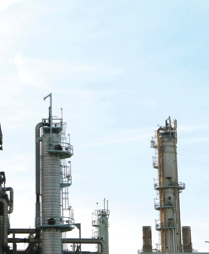Back Issues

Carbon credits, generated through the reduction of greenhouse gases, could be an added bonus for companies looking to incorporate alternative energy systems within their existing facilities. Alternative energy bonus In addition to delivering cost savings and environmental benefits, alternative energy systems can also deliver an added bonus: financial returns in the form of carbon tax credits. By Vicky Boyd
In weighing out how and when to proceed with the installation of a new alternative energy system, a big driver for many companies is the potential cost savings and environmental benefits that can be generated by employing alternative energy technologies, such as solar and wind. But there could also be an additional incentive in an emerging area: carbon credits, or offsets. Carbon credits, generated through the reduction of greenhouse gases, could be an added bonus for companies looking to incorporate alternative energy systems within their existing facilities. And globally, companies that have achieved CO2 reductions as part of the Kyoto Accord--possibly employing alternative energy technology--could find a way to convert any excess emission reductions into carbon credits and sell these credits. And for companies looking to finance new, stand-alone alternative energy projects, carbon credits can be added to their business plan as another source of revenue. This relatively new area of carbon tax credits is getting a fair bit of attention in the U.S., both from companies and operations that are interested in supplying credits--and receiving financial compensation--and companies in Corporate America wanting to purchase credits. So far, much of the carbon credits have been generated by agricultural operations, but the potential exists for companies to "monetize" a reduction in greenhouse gases. One utility company has already set up a business to help companies deal with their CO2 emissions. This past March, Green Mountain Energy, based in Austin, Texas, announced the launch of eMission Solutions, a portfolio of carbon reduction services for commercial and institutional sector clients looking to improve their environmental position. Green Mountain is said to be one of the nation's leading retail providers of cleaner electricity products, offering residential, business, institutional and government customers the choice to support cleaner electricity generated from sources such as wind, solar, water, geothermal and biomass. "With climate change, high energy costs, environmental concerns and increased focus on sustainable business practices by institutional investors, customers and other stakeholders at the forefront of today's global mindset, businesses are increasingly looking for ways to reduce their impact on the environment," says Gillan Taddune, chief environmental officer for Green Mountain Energy Company and head of the eMission Solutions division. eMission Solutions includes a wide range of carbon reduction products and services including Renewable Energy Credits (RECs), forest sequestration projects, and other carbon sequestration strategies. These products will allow companies to reduce their carbon footprint and offset the carbon emissions associated with business activities like transportation, production, electricity usage, and employee commuting and air travel. In support of this new initiative, Green Mountain Energy joined the Chicago Climate Exchange (CCX), a voluntary, multi-sector market for reducing and trading greenhouse gas (GHG) emissions. The Chicago Climate Exchange has been a central player in facilitating carbon credit trading. The CCX was created in 2003 as a voluntary way for participants in North America and Brazil to reduce greenhouse gas emissions one percent per year over baseline levels established from 1998 to 2001. The six greenhouse gases targeted are carbon dioxide, methane, nitrous oxide, perfluorocarbons, hydrofluorocarbons and sulfur hexafluoride.
 Start-up funding was provided by 28 companies, including British Petroleum, International Paper, DuPont, Westvaco and American Electric Power. It was used to pay for CO2 agricultural offset credits for four types of practices--no-till cultivation; grass plantings made after January 1, 1999; tree plantings made after January 1, 1990; and methane capture and combustion. The first three practices are forms of carbon sequestering, where plants remove CO2 from the atmosphere and transform it through photosynthesis into a long-lived, stable carbon form, such as wood or soil organic matter. Since the exchange's inception, more than 170 entities have become members, allowing them to trade carbon credits. They range from universities, municipalities, emission traders and state farm bureaus to some of the world's largest corporations, such as Ford Motor Co. and IBM. As members, they have agreed to reduce their greenhouse gas emissions four percent by the end of 2006 and six percent by 2010. They can achieve the goals internally, such as by planting trees or installing methane capture and combustion systems, or by trading credits. The exchange deals in what it formally calls Carbon Financial Instrument contracts, each representing the equivalent of 100 metric tons of CO2. Qualified landfill and agricultural methane capture and combustion projects earn 18.25 metric tons of CO2 credits for every ton of methane combusted. If agricultural producers use qualified conservation-tillage practices, they earn 0.5 metric tons of CO2 credits per acre per year. If they have planted a grassy cover after January 1, 1999, that meets exchange requirements, they earn 0.75 metric tons of CO2 credits per acre per year. Forestry projects begun after January 1, 1990, earn varying rates of credits, depending on their size and biomass. Small projects have a maximum gross CO2 accumulation of less than 2,000 metric tons annually. Medium projects have a maximum gross CO2 accumulation of 2,000 to 12,500 metric tons annually, and large projects have a gross CO2 accumulation of more than 12,500 metric tons annually. Companies and municipalities also can participate by installing renewable energy projects. For each megawatt of energy produced, they earn credits worth the equivalent of 0.4 metric tons of CO2. Registered and verified offset projects recognized by the exchange range from farm soil practices to fuel switching. The CCX has also developed standardized rules for issuing carbon credits for renewable energy generation from solar, wind, small hydro electric and biomass systems. The agricultural guideline practices also cover the generation of renewable energy through using methane--which had previously been released to the atmosphere--as fuel. CommonWealth Resource Management Corporation, a Boston-based energy consulting firm and project developer, has joined the Chicago Climate Exchange as an offset provider. The company's first two projects involve landfill methane in New England. CommonWealth plans to acquire the rights to the methane, which in turn gives them the rights to the credits or offsets created, which would then be traded on the CCX. From the two sites being used for generating CCX offsets, the methane will be used to generate electricity and treat leachate from the landfills. Dealing with everybody who has undertaken a greenhouse-gas-reduction project would be unwieldy. That's why climate exchange designated "aggregators"--entities that pool together projects to form the standard 100-metric-ton trading contracts. They also certify that the projects meet the exchange's requirements. The aggregators' role is similar to that of stockbrokers who have seats on the New York Stock Exchange--they sell credits on behalf of credit holders. With agricultural-related projects, the exchange hopes to eventually have an aggregator in each state that will pool together about 25,000 acres of no-till or grass plantings for four-year contracts. They may include farm bureaus or cooperatives that deal with a large number of producers. One such aggregator on the agricultural side is the Iowa Farm Bureau of West Des Moines, which has been involved with the Exchange from the start. David Miller, Iowa Farm Bureau director of commodity services, says becoming an aggregator fit well with existing programs the organization offers. "Part of what we do here at the Iowa Farm Bureau is we support a feeder cattle procurement program and risk management education," he says. "So we saw carbon credit trading as a service necessary in the market place. "We're kind of like the county elevator of carbon credits. We take anywhere from a pick-up load to a truck load and package those into standard units that can be sold on the exchange."  The farm bureau offers the carbon credit trading service to all of the state's farmers, whether or not they're members of the organization. As part of the service, the farm bureau hires a third party to verify the projects meet climate exchange requirements. Each year, about 10 percent of the contracts are spot-checked, and Miller says 99 percent comply. So far, the Iowa Farm Bureau has handled about 500,000 metric tons of carbon credits, Miller says. The farm bureau charges a 10 percent service fee for verification and handling credit sales. "We may get 250,000 tons certified at the same time, but we may take four to six months to a year to sell those credits," Miller says. Environmental Credit Corp. (ECC) of State College, Pennsylvania, another aggregator, focuses on projects that involve methane capture and combustion, says ECC president Scott Subler. "In many cases, the projects are too small to meet the exchange's minimum size requirements, so they need to go through an aggregator," he says. Unlike the farm bureau that charges a fee to handle carbon credits, Subler says ECC looks at becoming a partner in the project instead. "There's no fee," Subler says. "Basically, our compensation is success-based. Whoever puts in the bulk of the capital gets the bulk of the credit value." A dairy farmer, for example, may have an anaerobic digestion manure lagoon, and ECC will pay for the lagoon cover. "It isn't fancy, high-tech engineering--it's straight forward technology," Subler says. "Because of its low cost and simplicity, it's attractive to the farmer for other than methane capture, like odor control, water quality, ammonia control and volatile organic compounds." In December 2005, ECC delivered the first payments to dairy farmers for greenhouse gas reductions. Dairymen Darryl Vander Haak of Lynden, Washington, and Dennis Haubenschild of Princeton, Minnesota, together prevented the release of 720 metric tons of methane--the equivalent of 13,000 metric tons of CO2. At the market rate back then, the credits were worth more than $26,000. Vander Haak has installed a digester/renewable power generation system that prevents the release of methane. The methane is used to power a generating system that provides enough power to generate electricity for 180 homes. ECC also offers an added-value service through a separate credit pool. Comparing it to a mutual fund, Subler says, "Rather than getting paid as the credits are created, the partners pool gives them an opportunity to let them ride and bank their credits. Many feel the credit prices will continue to go up, which they have historically." U.S. Sen. Richard Lugar is taking stock in the environment and the evolution in carbon credits--by adding another 37 acres of mostly black walnut tress to the 200 acres of existing trees on his farm in Marion County, Indiana, near Indianapolis. Not only will the newly planted trees produce oxygen as they grow, they also may mean additional income--and not as wood or wood products, either. Lugar has enrolled his 600-acre farm as a carbon offset provider in the CCX and now qualifies for carbon trading credits. "It's another income stream for practicing good environmental initiatives--in this case, it's planting trees," says Andy Fisher, Lugar's press secretary in Washington, D.C. Fisher says the Indiana senator hopes the tree plantation sets an example that other farmers will follow. "Increasingly, the global community is recognizing the potential perils of climate change," Lugar said in a statement. "The ability of farmers and others to remove carbon from the atmosphere and store it through methods such as tree farming and no-till planting are an important part of the solution." Lugar already has earned 600 metric tons worth of certified carbon credits, although he hasn't sold any yet on the exchange, Fisher says. In early December, carbon credits for projects placed into service in 2006 were trading for $4.35 per metric ton on the exchange. Ultimately, Lugar could earn up to 3,400 metric tons worth of certified carbon credits. |








